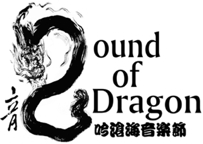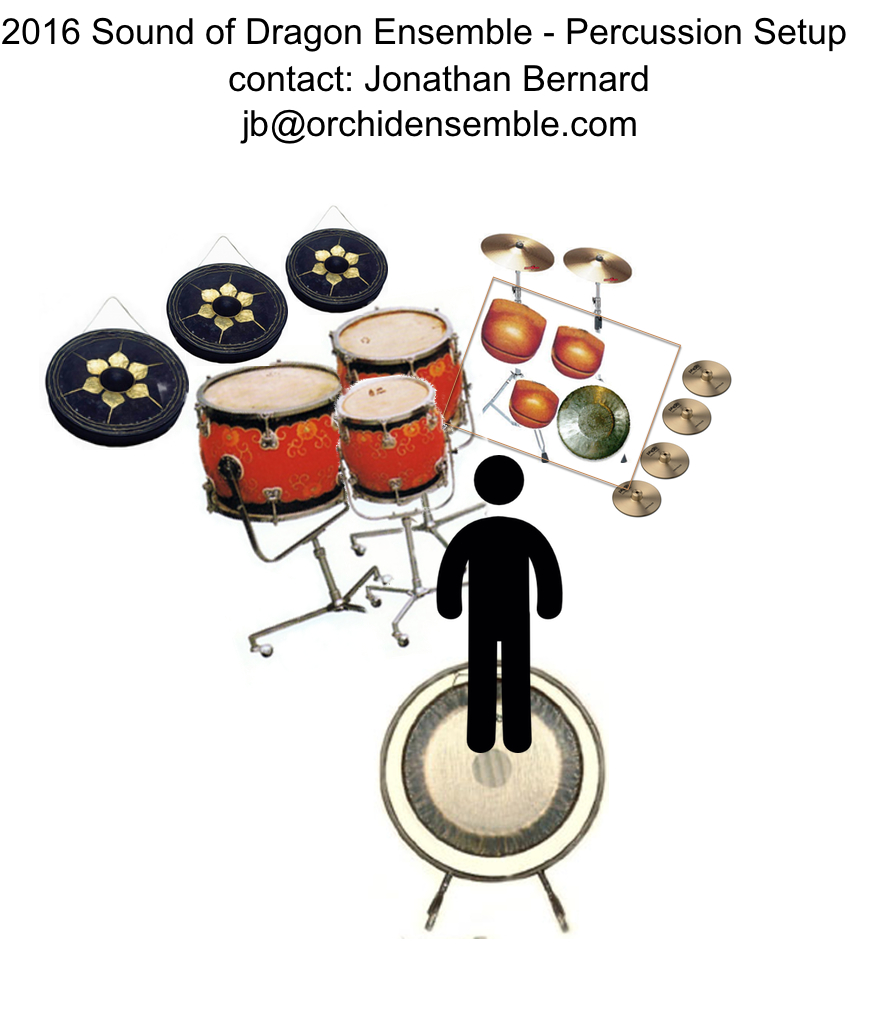Percussion List & Placement:
- 3 toms (lowest similar to the Bass Drum) – waist height, front left of the player
- 3 temple blocks & 1 small Chinese opera gong – waist height, front right of the player
- 3 pitched gongs (Choice of C#3, D3, Eb3, E3, F3, F#3, G#3) – chest height, player’s left
- 2 suspended cymbals (choice of standard dark, standard brighter, Chinese cymbal with strong D fundamental ‘pitch’, and splash cymbal) – one on the left above the toms; one on the right above the temple blocks.
- 4 crotales (choose from one high octave crotales concert C7-C8, written C5-C6) – player’s right, to the right of the temple blocks, hanging on strings at chest height
- tam tam – behind player
- other small instruments: shakers, rattles, flexatone, vibraslap, triangles, Chinese opera cymbals, maracas, cabasa…
- dumbek, riq
Please contact the Sound of Dragon Society if you want to use other small percussion instruments and not sure whether we can add to the list.
Tom tom or Chinese paigu (排鼓; pinyin: páigǔ; also spelled pai gu) is a set of tuned drums with skin head and metal rims. Tom tom refers to the traditional Chinese drums. Today’s paigu was developed in the 1960s in China. Each drum has two heads, one on the top, the other the bottom. They can be tuned to different pitches. The tuning range on each drum is between 4th~5th.
The temple block is a percussion instrument originating in eastern Asia, where it is used in religious ceremonies. It is a carved hollow wooden instrument with a large slit. In its traditional form, the wooden fish, the shape is somewhat bulbous; modern instruments are also used which are rectangular in shape. Several blocks of varying sizes are often used together to give a variety of pitches. The sound of temple blocks is similar to that of wood blocks, although temple blocks have a darker, more “hollow” timbre.
Chinese opera gongs – An essential part of the orchestra for Chinese opera is a pair of gongs, the larger with a descending tone, the smaller with a rising tone. Opera gongs range in size from 7″ to 12″, with the larger of a pair one or two inches larger than the smaller.
A pair of Chinese opera cymbals is essential in Chinese opera music. The diameters for each cymbal is between 15mm ~ 69mm. The players hold one cymbal in each hand and make them hit each other to produce sounds. Various techniques are used on these expressive instruments to produce different timbre and dynamics.
Tuned gongs – A nipple gong has a central raised boss or nipple, often made of a different metals than other gongs with varying degrees of quality and resonance. They have a tone with less shimmer than other gongs, and two distinct sounds depending on whether they are struck on the boss or next to it. They are most often but not always tuned to various pitches. Nipple gongs range in size from 6″ to 20″ or larger. Nipple gongs are used in Chinese temples for worship.
Crotales (/kroʊˈtɑːleɪz/), sometimes called antique cymbals, are percussion instruments consisting of small, tuned bronze or brass disks. Each is about 4 inches in diameter with a flat top surface and a nipple on the base. They are commonly played by being struck with hard mallets. However, they may also be played by striking two disks together in the same manner as finger cymbals, or by bowing. Their sound is rather like a small tuned bell, only with a much brighter sound, and a much longer resonance. Like tuned finger cymbals, crotales are thicker and larger; they also have slight grooves in them which give their sound more sparkle. Modern crotales are arranged chromatically. Crotales are treated as transposing instruments; music for crotales is written two octaves lower than the sounding pitch, to minimize ledger lines.
Tam Tam is a large flat gong that is played with soft mallets. It has a long decay. It produces a “crash” rather than a tuned note.








